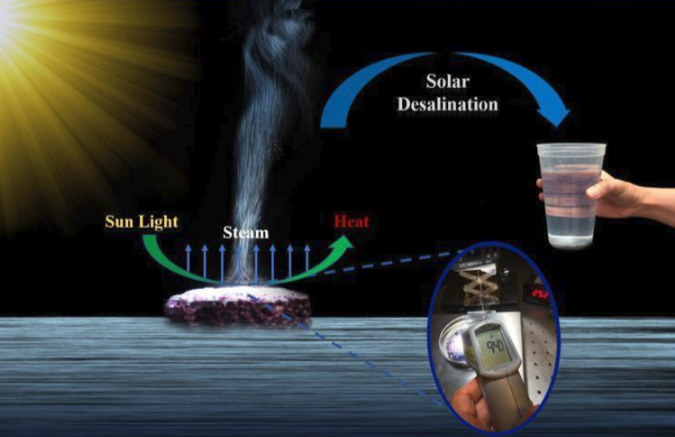Researchers at VCU Aiming to Improve the Process of Solar-powered Desalination
Published on by Water Network Research, Official research team of The Water Network in Technology
Could technology being developed at VCU help address global water scarcity? Research is aiming to improve the process of solar-powered desalination, which harnesses the sun’s power to remove salt from seawater.

The focus of this research has been to drive down the cost of materials and increase the efficiency of converting solar energy to heat. (Illustration source: VCU)
More than 2 billion people lack access to safe drinking water, and the United Nations projects that global demand for water will rise by nearly one-third by 2050. At Virginia Commonwealth University, researchers are helping to develop technology that is considered one of the most promising solutions to this global crisis.
“Water is becoming the world’s most important resource, more than oil,” said M. Samy El-Shall, Ph.D., professor and chair of the Department of Chemistry in the College of Humanities and Sciences. “The next conflict is going to be over water. Because [certain parts of the world are] running out of clean water. We need to solve this problem.”
El-Shall has been conducting research on improving the process of solar-powered water desalination, which is essentially technology that removes salt from seawater by harvesting radiation from the sun, converting that energy into heat that evaporates the water, and then capturing the resulting steam that can be condensed into freshwater.
While not a new process, the technology faces challenges when scaling up to a level that would help address the world’s water scarcity. The focus of El-Shall’s research has been to drive down the cost of materials and increase the efficiency of converting solar energy to heat.
Currently, solar thermal systems rely on copper or aluminum to collect solar energy, but those materials are expensive, have a limited availability and are not very efficient in absorbing the solar spectrum. As a result, current solar-powered desalination devices have low efficiency and low water productivity.
El-Shall and his research partners have developed a different, more cost-effective and efficient approach to solar steam generation.
“The cost of the materials is still high, and we use, for example, efficient materials like gold particles and silver particles, but they are expensive,” El-Shall said. “So we’re trying to avoid that by moving to much less expensive materials.”
The team essentially carbonized sheets of cotton that float atop a surface pool of seawater. The material has broad solar absorption properties and is flexible, porous, low weight and less expensive.
“The technology we’re developing only relies on the materials and the sun,” El-Shall said. “The materials have several requirements. They have to float on the surface of water and they have to absorb all the radiation from the sun, across many different wavelengths, and then convert that radiation to heat. That heat will create the steam, and that steam can then be condensed, basically to form water. You can condense it just on a cold surface. It’s a straightforward process.”
The process El-Shall and his colleagues are developing could be scaled from the household level up to a massive production facility.
“If you are in a place where there is no water and you have seawater, you could use a small, portable unit to convert it to a few liters a day or something like that. You could then regenerate this unit, and then use it again,” he said. “And on the other hand, you could use this technology on a very large scale, [such as] desalination plants.”
Beyond helping to solve global water scarcity, solar steam generation and solar water desalination have other applications, including industrial purposes, solar crop-drying technology, and water purification in remote regions.
A significant amount of research into solar-powered desalination is being conducted around the world, particularly in the Middle East.
“The direction now is to use solar because most of these places you have good solar [conditions]. So if this technology becomes more advanced and cheaper to use, I think this is the way to go,” El-Shall said. “Saudi Arabia for example, is investing billions of dollars for solar desalination.”
Source: VCU
Media
Taxonomy
- Treatment
- Drinking Water Treatment
- Technology
- Freshwater
- Desalination
- Solar Desalination
- Sea Water Desalinisation
- Sustainable Desalination
- Water Supply Design
- Drinking Water Managment
- Drinking Water